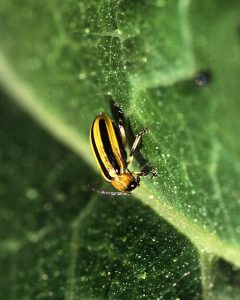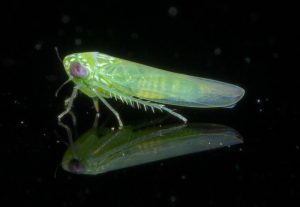Cumberland County Pest and Disease report 8/26
Prepare for more foliar infections with the onset of shorter days

Possible pests
Cucumber beetles
The striped cucumber beetle is one of the most damaging pests on cucurbits, such as squash, cucumber, melon and pumpkin. The larvae can cause severe damage to roots. A single beetle can cause severe damage to an emerging plant by feeding on the lower surface of leaves. Adults are known to feed inside flowers, preventing pollination and fruit set. These beetles also spread bacterial wilt, cucumber mosaic, and squash mosaic virus.
Management
Because overwintering cucumber beetles are around by the time cucurbits are up or transplanted, it is important to check at least daily to control the pest. Handpicking is most effective if done early in the morning. These beetles are easy to kill, but because more keep arriving on the plants, it sometimes seems as though controls are not effective. Barriers of row covers (which may have to be suspended over crops with wire hoops to prevent foliar abrasion in windy locations) such as spunbonded remay, cheesecloth, etc., can protect your plants; remove by midsummer to permit pollination.
Removal of goldenrod, aster, etc., from the vicinity of cucurbits helps reduce the number of beetles. Removing plant debris or keeping it to a minimum is also advisable.
Potato leaf hopper
Potato leafhopper (Empoasca fabae) damages crops through direct feeding on the sap. It is a piercing-sucking insect that causes injury referred to as “hopperburn.” This is characterized by necrosis of leaflets starting at the tips and margins resulting, with progress, in defoliation.
Adult potato leafhoppers are wedge or spindle-shaped, and about an eighth of an inch long. They appear bright lime-green to yellow green with white markings. Wings are transparent green and are folded back when at rest. They have a variable number of white spots on top of their head and along their thorax. Nymphs are similar to adults but are smaller and wingless. Several nymphal stages occur in the generation.
Cultural Controls:
- Early-season and red varieties of potato tend to suffer more damage than long-season varieties; varieties that are less susceptible include Katahdin, Russet Burbank, Russet Norkota, Ontario, and Red la Soda.
- Row cover can be used to delay infestation in snap beans until flowering, when plants are less susceptible to damage. Using row cover is recommended on young eggplant, as it protects from flea beetles, Colorado potato beetle and potato leafhopper.
Carrot rust fly maggot
Larvae feed on young fibrous roots and the larger tap roots. Their feeding results in tunnels that contain a rust colored frass, distorted and scarred crop, and reduced quality yield.Damage can also lead to infection of other pests.Adults do not directly feed on the plants. Large infections can cause yellowing, stunting, and death(especially young plants), but more commonly above ground parts show no visual problems.Therefore, above ground monitoring techniques such as sticky traps are vital for control.
Cabbage looper
All cole crops, including cabbage, broccoli, Brussels sprouts, cauliflower, and rutabaga, are susceptible to attack by this insect. In addition, cabbage loopers will also attack beets, celery, lettuce, peas, potatoes, spinach and tomato.
The use of transplants that are free of larval contamination is a key step in avoiding damage. Floating row covers can provide a physical barrier to cabbage loopers in small cole crop plantings. Natural controls are frequently quite effective in preventing buildups of cabbage looper populations.
University of Wisconsin cabbage looper fact sheet
Fall Webworm
Fall Webworm (Hyphantria cunea) – With large sprawling nests made of silken webbing, fall webworm is hard to miss and can often appear to have engulfed an entire tree. Much of the confusion between fall webworm and browntail moth arises due to the small size of the nests early on and that fact that both insects can be found on some of the same tree species. As with many other aspects of forest entomology, timing and patience are key. August and September are the prime months for fall webworm caterpillar activity.
If you observe a small nest of webbing during this time and have doubts as to which insect it belongs to, give it a week. If the size of the nest increases by magnitudes, chances are you have fall webworm. Additionally, the size of fall webworm nests should already be quite substantial by the time the small, tightly-woven winter nests of browntail moth caterpillars begin to appear later in the season.
Fall Home-Invading Insects: Various insects, such as ladybugs, boxelder bugs, seedbugs, and stink bugs will begin to seek overwintering shelters in warm places, such as homes, throughout the next couple of months. While such invaders do not cause any measurable structural damage, they can become a nuisance especially when they are present in large numbers. While the invasion has not yet begun, if you are not willing to share your home with such insects, now should be the time to repair torn window screens, repair gaps around windows and doors, and sure up any other gaps through which they might enter the home.
Possible Diseases
Botrytis- gray mold (tomatoes, potatoes and beans)
Botrytis at first appears as a white growth on the plant but very soon darkens to a gray color. Smoky-gray “dusty” spores form and are spread by the wind or in water. In greenhouses, any activity will result in a release of spores.
Botrytis must have nutrients or some food source before it invades the plant. Nutrients leaking from wounded plant parts or from dying tissue such as old flower petals provide the required nutrients. From this food base, the fungus becomes more aggressive and invades healthy tissue. A dark to light brown rot forms in the diseased tissue. High humidity conditions favor the growth of this fungus.
Management
- Sanitation is the first important step. Remove dead or dying tissue from the plants and from the soil surface. Remove this refuse from the greenhouse. Do not throw debris under benches or on walks. Sanitation alone is not sufficient to control this fungus. The fungus can produce 60,000 or more spores on a piece of plant tissue the size of your small finger nail. Even one spore can infect a plant and cause disease.
- Avoid injuring plants in any way. Do not leave large stubs of tissue on stock plants when taking cuttings.
- Heat and ventilate greenhouses to prevent high humidity conditions. Outdoor planting should be planned to provide good air circulation patterns. This is the most important means of inhibiting Botrytis activity.
Early blight; Photos – early blight
Early blight of tomato, caused by the fungus Alternaria solani, is perhaps the most common foliar disease of tomatoes in the Northeast and is also common on potatoes. This disease causes direct losses by the infection of fruits and indirect losses by reducing plant vigor. Fruit from defoliated plants are also subject to sunscald. Alternaria sporulates best at about 80ºF when abundant moisture (as provided by rain, mist, fog, dew, irrigation) is present. Infections are most prevalent on poorly nourished or otherwise stressed plants.
Symptoms
Early blight produces a wide range of symptoms at all stages of plant growth. It can cause damping-off, collar rot, stem cankers, leaf blight, and fruit rot. The classic symptoms occur on the leaves where circular lesions up to 1/2″ in diameter are produced. Within these lesions dark, concentric circles can be seen. The leaf blight phase usually begins on the lower, older leaves and progresses up the plant. Infected leaves eventually wither, die, and fall from the plant.
UMaine early blight fact sheet
Septoria Leaf spot
Septoria leaf spot is caused by the same wet conditions that favor the development of early blight of tomato and potato. Septoria leaf spot and blight is a common foliage disease of tomato caused by Septoria lycopersici.
Symptoms are evident in the foliage, particularly older (lower) leaves. Septoria blight causes numerous small (about 1/8″ to 1/4″ in diameter) brown spots that develop light tan to white center as they age. The overall effect of both blights is similar. Leaves turn yellow, brown, then wither and die.
Management
Cultural techniques can help to reduce the risk of foliar blight outbreaks. At the end of the season, remove as much tomato plant debris as possible from the planting. Rotation away from tomatoes and potatoes for 3 to 4 years also helps to break the debris link in the disease cycle. If a long rotation is not feasible, a 2-4″ layer of organic mulch (chopped deciduous tree leaves, grass clippings, straw, etc.) placed over the soil surface after transplanting acts as a barrier against release of fungal spores. Planting density or spacing, as well as sucker pruning and trellising improve air movement and reduce humidity needed for disease development. Reducing overhead watering (to reduce spores splashing from leaf to leaf and from leaf debris) also helps.
Scab (potatoes);Photo Potato common scab
Potato scab is a common tuber disease that occurs throughout the potato growing regions of the world. Individual scab lesions are circular but may coalesce into large scabby areas. Insects may be involved in creating deep pitted lesions. The term “common scab” generally refers to the response of the disease to soil pH. Common scab is controlled or greatly suppressed at soil pH levels of 5.2 or lower. Common scab is widespread and is caused by S. scabies.
Recommended Disease-control Strategies
1. Use resistant varieties in fields where scab is a problem
3. Rotate heavily infested fields away from potatoes and alternate hosts such as radish, beets, and carrots. Use small grains, corn, or alfalfa in rotations; avoid red clover.
4. Maintain soil pH levels between 5.0 and 5.2 by using acid-producing fertilizers such as ammonium sulphate. Avoid or limit the use of such alkaline-producing amendments as lime and manure.
5. Avoid moisture stress during the 2 to 6 weeks following tuberization.
Cornell potato scab fact sheet
Powdery mildew (summer squash and pumpkins);Photos – powdery mildew
Introduction
Powdery mildew of cucurbits is caused by either of two fungi. Sphaerotheca fuliginea (less common) is known to infect about 60 plant genera and Erysiphe cichoracearum is known to infect about 160 plant genera. All cucurbits are susceptible to powdery mildew although it does not commonly attack watermelon. Yield losses of up to 50% have been reported and are the result of defoliation caused by the fungi.
Environmental Conditions
Unlike most fungi, the spores of powdery mildew do not require free water for germination and are actually inhibited in its presence. High humidity is beneficial but not necessary for spore germination. Infection has been known to occur below a relative humidity of 50%, although the humidity at the surface of the leaf is undoubtedly higher. High humidity also increases the rate at which the fungus grows after infection occurs. Spores will germinate above 50°F with an optimum of around 80°F and an upper limit of 90°F.
Symptoms
The initial signs of the fungus show on the upper or lower surface of (especially) shaded leaves. The infection may appear first as a pale yellow spots but the fungus soon sporulates yielding a characteristic powdery-white appearance (brown in the case of Sphaerotheca). This powdery appearance can involve the entire leaf which eventually turns yellow then brown and dries to the point that it crumbles when crushed.
